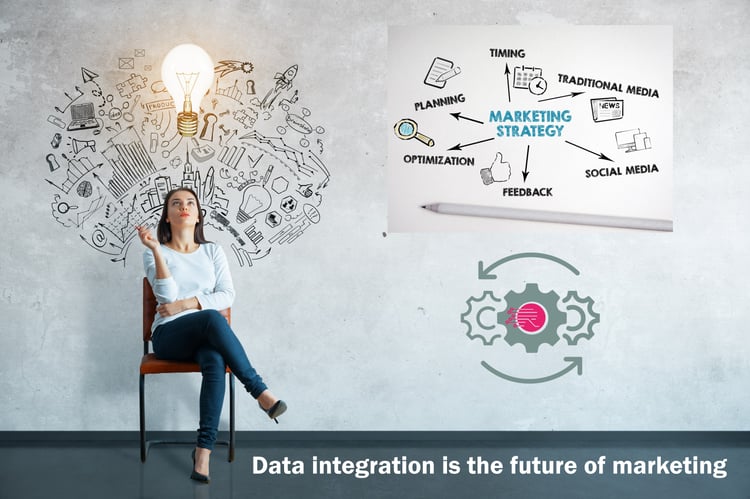Marketing is at the heart of most companies’ strategies. Marketing is the gatekeeper and promoter of a company’s image and reputation. Marketing follows market trends and adapts to them to find new potential customers.
Marketing departments worldwide do all this and much more: establish and maintain communication channels with customers, boost sales efforts while feeding the rest of the organization with new market trends and business insights.
However, any marketing leader will tell you that anticipating or even following marketing trends is not always the easiest task. Marketing is probably the discipline in enterprises that has evolved the most in the past 25 years. Nobody does marketing today the way they did back then.
This article will investigate why system integration is the IT trend that best supports all new marketing trends.
A jungle of marketing trends
Marketing campaigns, email marketing, content marketing, social marketing, influencers marketing and more. Along the years, it has sometimes been challenging to keep up with the ever changing ways to reach out to potential customers.
In this jungle of new trends and latest fashions, from artificial intelligence to influencer marketing, one is here to stay. Customer knowledge is the key to successful marketing.
Top quality relevant customer data means successful email marketing, satisfied existing customers, rewarding customer interactions, efficient sales teams and spotless customer service. As a consequence, customer data has become the goldmine of marketing.
Data collection was without a doubt a strong marketing focus the past 20 years. CRM software and marketing have become inseparable and marketing executives worldwide have invested heavily in, among others, CRM and marketing automation systems.
Collecting huge amounts of data is very good - being able to use this data is even more important. This is where data integration can come handy.

What data integration means for marketing
For marketing executives, data integration means combining customer information from various sources into something useful. It’s about efficiently managing customer data and making it available to those who need it.
Generally, data integration is the discovery, cleansing, monitoring, transforming and delivery of data from a variety of sources. If you are a marketer, you know that data integration can make or break your marketing analytics.
To drive marketing activities, you need to collect information from many different sources, whether they are social media platforms, ERP solutions, CRM tools or even Excel files on a colleague’s laptop.
It is not uncommon for marketing departments or agencies to use up to 50 different technologies on a daily basis to keep track of their customers’ activities and their purchasing journey.
Before data integration, marketers had to deal with data stored in siloed data centers – sometimes in different locations around the globe, in different formats. With data integration, marketers can access all this data from one place.
WHY IS DATA INTEGRATION SO IMPORTANT FOR MARKETERS?
Marketers are already working with an overwhelming increasing amount of data, but it’s only just the beginning. IDC explains that the global pandemic has led global organizations to increase and accelerate their digital transformation. As a result digital transformation investments should account for 55% of ICT investments by 2024.
This means new or updated systems to collect and transform more and more data. Integrating data sources and marketing technologies will therefore become more vital than ever for companies, whether B2B or B2C. Without it, it will be difficult to successfully deliver relevant customer experiences and drive accelerated sales revenue.
System integration offers one single, consolidated source of customer information. This data is collected from CRM platforms, data warehouses, marketing automation softwares and any other digital marketing tools.
This data is then synced so that all marketers can use the data they need to manage and optimize marketing through KPIs, metrics and dimensions. They can do that because they know that it is data they can trust. It is not incorrect or outdated.
This would not be possible with separated, individual and siloed source systems. Marketing is responsible for attracting, engaging, converting and retaining audiences and customers that move across many touchpoints.
In order to scale marketing’s performance and impact, one consistent and connected view is needed to evaluate which programs, channels, campaigns, audiences etc. are best driving their strategic goals. Marketing can define the future of your organization – and data integration is the future of marketing.
This is important for large corporations and small businesses alike.
DATA INTEGRATION IS THE WAY TO GO – BUT WHERE DO YOU START?
Establishing that data integration can be a tremendous helping hand to marketing is not difficult. Choosing the right data integration tool can be a more difficult task. A good place to start integrating data is where the core of your customer information lies – in your ERP and CRM systems.
Your CRM solution fuels your organization with new business, and your ERP system allows you to manage and drive your business around obstacles. These two systems allow you to deliver according to the promise made to your customer, and do it in a profitable manner.
By integrating the two systems, you will provide your marketers and your sales force with much-needed information that can be shared with new stakeholders.
From an operational point of view, you can achieve much greater benefits by integrating the two systems. For marketers, this is the first step towards getting the much desired 360 degree view of their customers.
From prospect, to sales and support, to finance and accounting, together these systems provide complete visibility into your customers’ needs, buying habits, order history, preferences, account standing, etc. you get better insight into your customer base, and you can use it to build lasting relationships with customers and determine where there is potential for future growth.

DATA INTEGRATION: IS IT COMPLICATED?
Some years back, it was common to handle data integration by building direct batch interfaces. This solved the data integration challenge by extracting data to a file that was then sent to the target system and imported via another batch job.
Such rudimental solution required a lot more work upfront, both in terms of programming and in testing. Some of the pitfalls of that method were that:
- you had to figure out how to deal with incorrect data
- you had to be able to keep the systems in sync afterwards
If the systems remain untouched, then this could run for years. When you work with agile systems like ERP and CRM systems, it is more cost-efficient and a lot more robust to use a data integration platform.
When you choose a data integration platform, most of the implementation workload is reduced to a simple configuration and mapping of data.
Data integration projects are rarely as complex as they have been. Delaying an integration project because of a fear from its complexity is no longer a valid reason.
With today’s technologies, setting up data integration projects is a different experience, one that can be done without changing a single line of code in your programs.
Companies rarely lack the bandwidth to implement a system integration project. With a solution like the RapidiOnline data integration solution, you can implement an ERP-CRM integration within 3-8 man days in total depending on the scope.
The trickiest part is probably to decide which data you should integrate. If you are interested in that topic, I invite you to read about the 9 most common ERP-CRM integration points.










